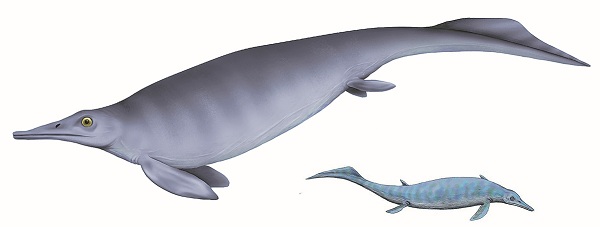New prehistoric species found in Guangxi


An artistic reconstruction of the new species of ichthyosaur. [Photo for China Daily]
Chinese scientists have discovered a new species of ichthyosaur, an extinct marine reptile, based on a fossil collected from Baise in the Guangxi Zhuang autonomous region.
It has been named Baisesaurus robustus and is the largest Early Triassic ichthyosaur ever discovered in the country. It was more than 3 meters long and is believed to have had a stronger swimming ability than earlier forms of the marine reptile previously discovered in China. The Early Triassic period dates from 251.9 million to 247.2 million years ago.
The discovery has also extended the known geographic range of ichthyosaurs in China, indicating the reptiles were more widely spread in the Early Triassic period than previously assumed, said Han Fenglu, an associate professor at School of Earth Sciences of China University of Geosciences (Wuhan). The findings have been published in the biological journal PeerJ.
The research was conducted by a team from the School of Earth Sciences in collaboration with researchers from the Guizhou Geological Survey Institute, the University of Alberta in Canada, and the Wuhan Geological Survey Center of the China Geological Survey.
In 2017, Guizhou Geological Survey Institute field crews found vertebrate bones exposed in limestone in the Zhebao region of Guangxi Zhuang autonomous region and invited other researchers to join the study of the specimen.
At the Wuhan Geological Survey Center researchers restored the fossil over three months and found it consisted of the front part of the trunk skeleton, including some vertebrae and ribs, a limb bone, and abdominal bones called gastralia proximal.
The disarticulated nature of the skeleton, combined with the good preservation of individual elements, suggested that the fossil was buried essentially in situ, but that water currents may have disturbed the skeleton after muscle and soft connective tissue decayed, the study said.
After multiple comparative studies and statistical analysis, the researchers identified the ribs as being relatively slender and not thickened where they connect to the body; the ribs on the lower side had long, thin protrusions in the middle. These are characteristics unique to ichthyosaurs, Han said.
First appearing about 250 million years ago, ichthyosaurs were active in the Triassic and Jurassic periods, around the same time as dinosaurs, and became extinct about 90 million years ago. They had streamlined, fishlike bodies, large eyes and a powerful tail fin.
Scientists suspected they may have evolved from terrestrial reptiles, but their origin and early evolution have remained a mystery. Other ichthyosaurs that were found-in Japan, Canada, northern Europe and Hubei and Anhui provinces-also dated to the Early Triassic period. They were mostly small with a length of up to 1.5 meters.
Ichthyosaurs previously discovered in China-represented by the Chaohusaurus in Chaohu, Anhui-were mostly less than 1 meter in length and had weak swimming and migratory abilities.
"Compared with other early ichthyosaurs, Baisesaurus had longer and stronger forelimb bones. That suggests the Baisesaurus may have had a stronger swimming ability and perhaps could have gone longer distances in oceans and made migrations in the ancient Tethys Ocean," Han said.
"Baisesaurus was also the largest Early Triassic ichthyosaurs in China, and may have played the role of advanced predator," he added.
MOST POPULAR
- 1 $39.7 billion worth of deals inked at Airshow China
- 2 China announces tax relief measures to stabilize real estate sector
- 3 A look at China's economy in October, 2024
- 4 Public holiday extension announced
- 5 China's NEV annual production hits 10 million milestone amid global carbon reduction efforts
Editors' Picks
 Infographic:
Golden jubilee of China-Brazil relations
Infographic:
Golden jubilee of China-Brazil relations
 Infographic:
A look at China's economy in October 2024
Infographic:
A look at China's economy in October 2024





